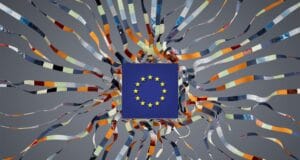Europe has set the goal to become fully circular by 2050. Central to this vision is the deployment of digital product passports (DPPs), a new technology that provides organisations with detailed information about the entire lifecycle of a single product. In the end, this helps organisations to change their view on how they produce, use, and recycle goods and helps them to make their operations more sustainable and efficient. Where does Europe currently stand with regards to the development of DPPs? We spoke with Sjoerd Rongen, Digital Product Passports Lead at TNO and associated with the CoE-DSC, about the necessity, future implementation, and potential benefits of DPPs.
New legislation as the core driver for the development of DPPs
According to Sjoerd, Europe’s ambition to be circular by 2050 is underpinned by new legislation and action plans. “Upcoming legislation, such as the Corporate Sustainability Reporting Directive (CSRD), mandates organisations to not only report on their own direct and indirect CO2 emissions (scope 1 and 2), but also on the emission of all suppliers in a company’s value chain (scope 3). Besides, the Circular Economy Action Plan (CEAP), a key component of the Green Deal, aims to ensure that resources are reused and recycled in the entire European economy.”
However, one of the significant challenges for organisations to comply with legislations and to commit themselves to European green and circular initiatives, is the lack of detailed information about where they currently stand. For instance, without detailed insights into product composition and lifecycle, it is difficult to make sustainable decisions or comply with the goals that Europe aims to achieve. Digital product passports (DPPs) are uniquely positioned to fill in this gap. Actually, the implementation of digital product passports is one of the key actions that the CEAP prescribes.
DPPs provide detailed information about the entire lifecycle of a product
DPPs are IT tools that provide insight into the full lifecycle of a single product, which can be anything from a plastic bottle or a piece of clothing to a high-tech semiconductor. For example, it clarifies where a specific product was produced and under what circumstances, how it was created and what raw material or components it consists of. Sjoerd: “When organisations have access to this kind of detailed information, they get a much clearer picture of their emissions than they have nowadays, which helps them to improve their sustainability reporting. On top of that, policymakers can be provided with accurate data to measure circularity on a broader level. For example, to get an idea of the proportion of recycled materials used in consumer goods in a single year. Currently, such data is unavailable or fragmented, hindering the ability to gauge progress accurately.”
How DPPs help Europe cope with geopolitical challenges
Sjoerd emphasises that the benefits of DPPs go beyond sustainability reporting purposes. DPPs can help Europe deal with geopolitical challenges. “One of the first DPPs that will be rolled out, as a result of the CEAP, is a DPP for batteries. Europe’s dependency on imported lithium highlights the geopolitical risks and the need for better lifecycle management. A digital battery passport will contain detailed information about a battery’s condition, allowing for repurposing rather than disposal. For instance, a passport can identify opportunities for repurposing and thereby extend the lifecycle of batteries, such as using them for grid stabilisation if they are no longer suitable for electric vehicles.”
Enhanced transparency will make manufacturing processes more efficient
Apart from extending the lifecycle of products, Sjoerd believes that the enhanced transparency that DPPs bring will also allow organisations to make their own manufacturing processes more efficient, which helps to reduce costs. Sjoerd: “When you have all the information about a product, you can start designing applications that add value. For example, if you know how the product is made and what it consists of, such as the hardness of the steel, you can use this information to fine-tune the machines in a factory, enabling more efficient bending of steel plates.”
Sjoerd also sees huge benefits for the semiconductor industry when it comes to testing newly made products. “Newly made high value, low volume products always need testing, yet very few products are available for this purpose since only a few prototypes are made. If you have a much clearer understanding of the material a product is made of and how it has been processed, you can precisely calculate an accurate final result, limiting the need for destructive product testing.” Another practical application where this precision is evident, is during product recalls. “It takes several months to manufacture chips and it involves many production processes. Occasionally, a few chips from a large batch may not work correctly due to a small failure somewhere in the production process. . However, without visibility into all the production processes, determining which of these to recall can be challenging. The only option is to recall all chips produced in a period, even if these are already assembled in a final product. For instance, if these chips are used in a certain car component, it might mean recalling all cars of a certain brand produced in a specific year for inspection. This is extremely costly, especially if it turns out that only the chips used in a few components that are still in the factory are affected. By having detailed insight into the production processes, manufacturers can avoid unnecessary costs and avoid waste.”
CIRPASS2 aims to create a generic, domain-agnostic architecture for DPPs
As regulations evolve, more sectors will adopt DPPs, starting with batteries and textiles, and extending to the built environment, semiconductors, and steel industries. However, standardisation of DPPs is needed to develop DPPs that will be interoperable. Sjoerd: “Several projects are underway to develop and standardise DPPs. The CIRPASS2 project is a significant initiative aimed at creating a generic, domain-agnostic architecture for DPPs. This framework will allow different sectors to develop their specific requirements while maintaining overall interoperability. However, achieving a unified standard for DPPs remains a challenge, as different industries have unique needs and data structures. Digital product passports will likely be implemented in a decentralised manner, with sector-specific DPP providers facilitating data sharing. This approach is similar to the organisation of data spaces, where data is managed in a decentralised manner. The future of DPPs depends on collaboration among stakeholders to develop standards and maximise their added value. By engaging with initiatives like CIRPASS2, industry players in the Netherlands can help shape the future of DPPs and contribute to the creation of European standards.”
Do you want to learn more? Sjoerd hosted a session about Digital Product Passports at our Community Meeting of May. You can either download his presentation slides, or watch the recording.
Download the slides or Watch the recording
Do you have any questions or ideas? Or do you want to help shape the future of DPPs? Please contact us at info@coe-dsc.nl




